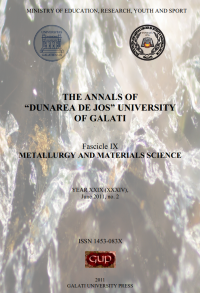The Use of Magnetic Nanomaterials for the Retaining of Cu(II) Ions out of Residual Water
Abstract
In the developed countries the removal of hard materials from residual waters using advanced technologies such as ionic change, precipitation, ultrafiltration or electrochemical deposits seems inconvenient from the economic point of view for the industry because its high costs. Therefore, it is necessary to introduce new technologies that imply low costs.
By linking chitosan and magnetite particles (Fe3O4), a new magnetic adsorbent with 100-200 nm particles and of great efficiency to move off the metalic ions is obtained. That is why this study aims to obtain a new magnetic material with great efficiency to retain copper out of synthetic solutions, and then to compare it, from the retaining point of view, with simple synthesized magnetide (Fe3O4).
Downloads
References
[2]. Ben-Shalom, N., Kudabaeva, N., Borisover, M. - Chemosphere, 59, p. 1309 -1312, 2005.
[3]. Chiou, M.S., Li, H.Y. - “Adsorption behavior of reactive dye in aqueous solution on chemical cross-linked chitosan beads”, Chemosphere, 50(8), p. 1095-1103, 2003.
[4]. Fergusson, E. - The Heavy Elements Chemistry, Environmental Impact and Health Effect, Pergamon Press, Inc., New York, p. 400, 1990.
[5]. Ho, Y.S., & McKay, G. - Pseudo second-order model for sorption processes. Process Biochemistry, 34, p. 451, 1999.
[6]. Li, B., Jia, D., Zhou, Y., Hu, Q., Cai, W. - In situ hybridization to chitosan/magnetite nanocomposite induced by the magnetic field, Journal of Magnetism and Magnetic Materials 306, 223–227, 2006.
[7]. Liu, X., Hu, Q., Fang, Z., Zhang, X., Zhang, B. - Magnetic chitosan nanocomposites: a useful recyclable tool for heavy metal ion removal. Langmuir 25, 3–8, 2009.
[8]. Nascimento, M., Soares, P.S.M., de Souza, V.P. - Adsorption of heavy metal cations using coal fly ash modified by hydrothermal method, Fuel 88, p. 1714-1719, 2009.
[9]. Starkar, N.S., Hilt, J.S. - Magnetic hydrogel anocomposites for remote controlled pulsatile drug release. Journal of Controlled Release 130, 246–251, 2008b.
[10]. Wang, Y., Li, B., Zhou, Y., Jia, D. - Chitosan-induced synthesis of magnetite nanoparticles via iron ions assembly. Polymers for Advanced Technologies 19, 1256–1261, 2008.
[11]. Zhou, L., Wang, Y., Liu, Z., Huang, Q. - Characteristics of equilibrium, kinetics studies for adsorption of Hg(II), Cu(II), and Ni(II) ions by thiourea-modified magnetic chitosan microspheres. Journal of Hazardous Materials 161, 995–1002, 2009a.
[12]. Zhou, Y.T., Nie, H.L., White, C.B., He, Z.Y., Zhu, L.M. -. Removal of Cu2+ from aqueous solution by chitosan-coated magnetic nanoparticles modified with a-ketoglutaric acid. Journal of Colloid and Interface Science 330, 29–3, 2009b.



